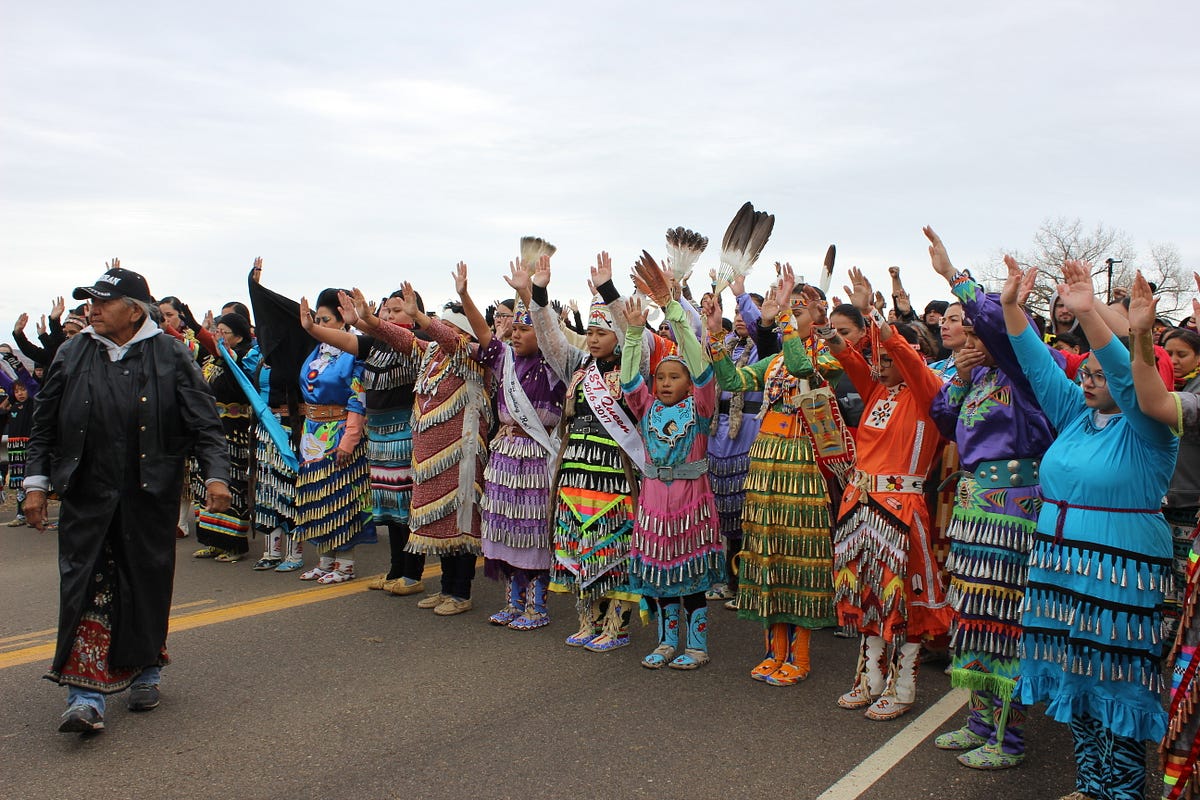‘We Have Come to Dance for Our People.’


Disputed Highway 1806 Near Cannon Ball, North Dakota, Saturday, October 29th, 2016
About 150 men, women, and children set out on foot from Oceti Sakowin camp, near the Standing Rock Sioux Tribal Reservation. In the lead, wearing a headdress of stunning long white feathers tapering into black, is Lakota Chief Arvol Looking Horse, spiritual leader of the Sioux Nation. The colorful flags of hundreds of tribal nations proudly wave on tall makeshift poles, lining either side of the self-described “water protectors” path. Under grey and cloudy skies and a fresh cold spell, the mood is somber.
The march turns right out of Oceti Sakowin onto Highway 1806, flanked on all sides by men from the camp acting as security guards. They don’t have far to walk. Perhaps a quarter of a mile north atop a small bridge above an even smaller tributary leading east to the Missouri River lie the burned carcasses of two giant trucks and a car that had been torched less than 36 hours earlier. The blaze marked the ignominious end to a day that will surely be recorded as one of the most significant oil battles in the history of the United States.
The marchers stop about 20 feet from the debris; the line of security guards standing as a buffer between them, the barricade, and what lies beyond.
On the opposite side of the wreckage is a large armed force of police, National Guardsmen, and private security in the employ of Energy Transfer Partners, the company behind the Dakota Access Pipeline. Their vehicles, including multiple armored Humvees, form one line parallel to the bridge and another that stretches up along the Highway to the north. Humvees are also situated on every available hilltop. Further north is the Dakota Access Pipeline, actively under construction on the same ground on which the October 27th standoff was fought.
Though the combined police force has been holding this location 24 hours a day for two straight days, nothing has been done to remove the destroyed vehicles, which serve (as they still do today) as a blockade keeping the water protectors away from the pipeline.
Many of the water protectors gathered here have not slept since that night; they have either been in jail or in search of incarcerated friends and loved ones. Some have been injured physically, as well as mentally and spiritually. Others are simply in a state of shock. Many, including the camp security, are ill at ease, uncertain about the advisability of being this near the bridge.
Nonetheless, the group has come here to pray.
“It took years to fight the Keystone XL oil pipeline,” intones Tom Goldtooth, a Dine’ and Dakota from Minnesota, and the executive director of the Indigenous Environmental Network. Success, he explains, came because they knew “to keep prayer first.”
Imperceptibly at first, the mood slowly begins to shift. It takes a moment to realize the source.
They arrive at first in a trickle of groups of twos and threes. Without a word, women and girls join the circle. As their numbers swell, the mood brightens. They are obliterating the grey sky and mood with an array of brilliant color bursting forth from clothes, beads, shoes, and jewelry in seemingly every hue. A crisp “jingle” accompanies their entrance, as they move, and as the wind catches hold of their dresses; each garment is adorned with rows of silver metal cones, called ziibaaska’iganan in Ojibew. As the cones strike one another, they emit an ethereal sound of hundreds of tiny chiming bells.
A call had gone out just the day before for Jingle Dress Dancers to gather here and offer their prayer and healing, Goldtooth explains. From many states and tribal nations, they heeded the call.
https://www.facebook.com/antonia.juhasz/videos/1320637307970336/
As the women dance, a collective breath is released. The healing has begun. Delight and joy move across the faces of onlookers, many of whom even break out into a shared laugh with a young girl enthralled by the presence of so many media cameras filming her.
On the other side of the bridge, a group of law enforcement officers emerge from their vehicles, edging closer to their side of the barricade. For perhaps the first time in days for many here, if not months, their presence is not ominous; rather, it is clear that they too are watching the dance.
When it is over, and after each dancer embraces and thanks the other, two older women volunteer to explain the dance’s significance, particularly to the non-natives among them.
“All the jingle dancers understand the power of the dress and feeling that we get when we dance the jingle dress dance,” says the first woman, who does not give her name. “This is how we say our prayers, send our prayers up.” Black wool gloves and a dark brown fedora, worn to fend off the increasing cold, compliment the brown of her jingle dress, brightened by a yellow belt with roses of many colors and matching brightly colored ribbons sewn onto her sleeves.
The jingle dress originated from the Ojibwe, “our first nation, and this is where we get our teachings from,” she says. The dance today offers healing to “put an end to this suffering that’s out here” she says, nodding in the direction of the Humvees and the Dakota Access Pipeline. “We have come to dance for our people.”
Ms. Callinghawk speaks next. It took her four years to make her dress, she tells us, its red and white design adorned with bright yellow ribbons to which her jingles attach (I am later told that most jingles today are made from the tops of Copenhagen snus boxes).
Her voice quickly takes on the timbre and tone of a practiced storyteller, and the crowd settles in for a good tale.

Photo: Antonia Juhasz
When she was done making her dress and ready for the upcoming ordeal, she went out (she does not say where) to fast. Looking up, she says that the same hills surrounding us today came to her in a dream that night. An elderly silver-haired woman in a buckskin dress came down from the hills. “She starts singing a song,” Callinghawk says. “I looked at her, I said, ‘I’m not here for songs, I’m here with my dress!’ She looks at me, she kind of smiles and she tells me in the Ojibew language, ‘You’ll know when it’s time, you’ll take this song.’” Now, it seems is one of those times.
Callinghawk saw pictures of the events of October 27th and knew she had to come to Standing Rock. She knew the healing power of the dress. As she drove, “the closer we got, I could feel my dress getting ready, I could feel the strength,” she says. The healing power had begun.
